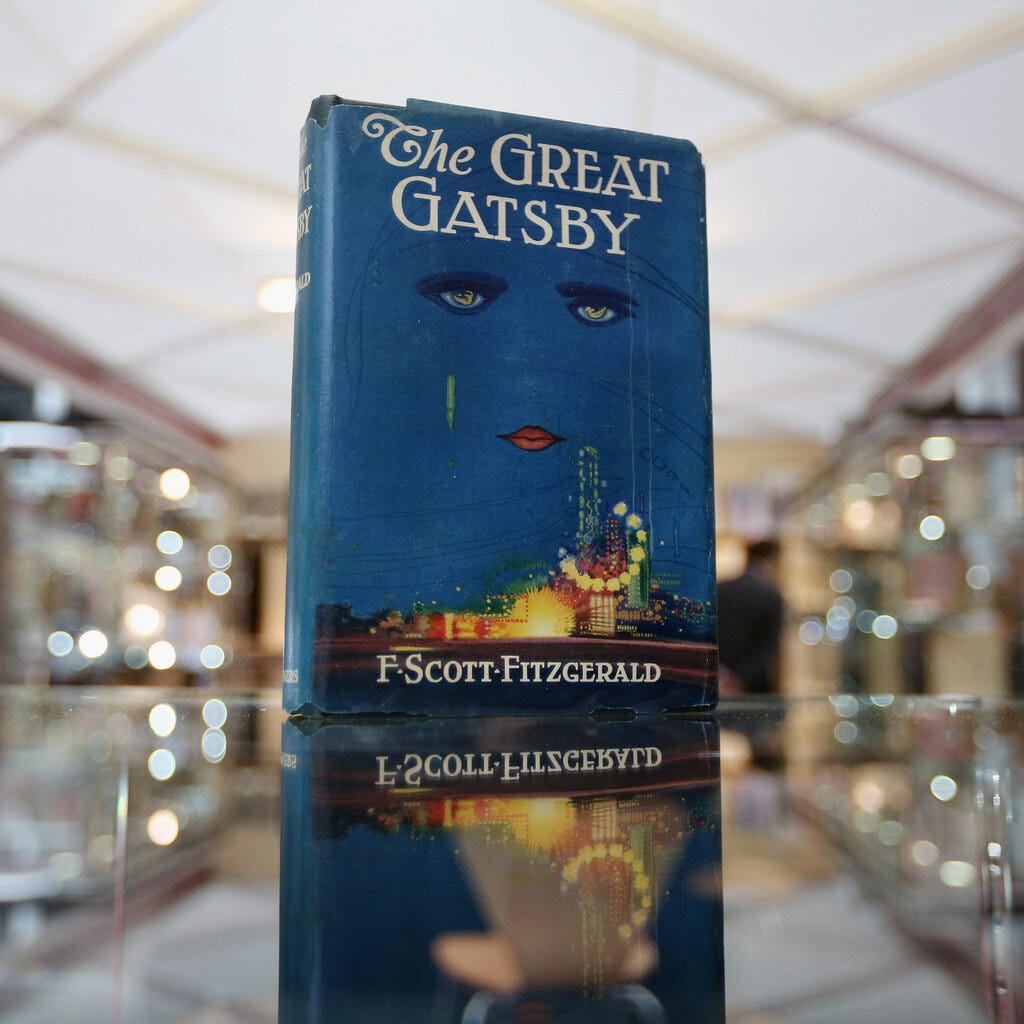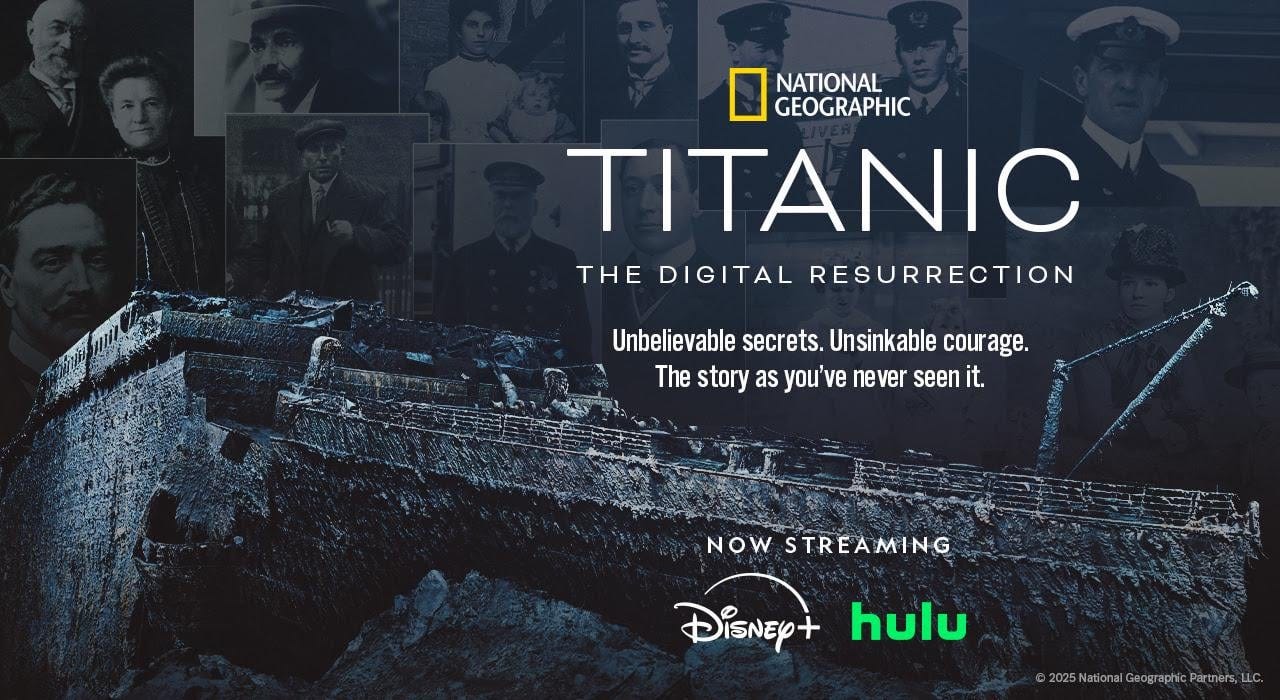When I was a kid, I used to mark the dubious events that took place on my birthday, April 15, by reciting:
Income tax day in the United States since 1955.
The Titanic sank in 1912 (it hit the iceberg on the 14th but sank on the 15th)
President Lincoln died in 1865 (he was shot on the 14th but died on the 15th)
And I shared my birthday with the great TV actress, Elizabeth Montgomery, star of the series, “Bewitched” and daughter of actor Robert Montgomery. Also, the actual, original “Renaissance Man,” Leonardo da Vinci. Good company!
Later, the date became associated with a few more tragedies:
The Boston Marathon bombing in 2013
The fire at Notre Dame Cathedral in Paris in 2019
And I found a LOT more Hollywoody type folks who shared my birthday: Emma Watson, Emma Thompson, Seth Rogan, Chris Stapleton…and blues singer Bessie Smith! More good company.
I didn’t want this month to pass without marking a few important April anniversaries and updates.
The Great Gatsby is 100!
Published on April 10, 1925, The Great Gatsby was first released to the public 100 years ago and it deserves honor for its longevity as well as its incredibly beautiful writing. F. Scott Fitzgerald was 29 when his greatest book was published. He hated the title and preferred “Trimalchio in West Egg” but no one today would get the reference. We don’t study the Greeks like we used to. Trimalchio was a legendary fictional party thrower, both arrogant and ostentatious, much like Jay Gatsby as he searches for his lost love.
The Great Gatsby was well-received by the public but was not a best seller. Its fame endured thanks to the World War II Armed Services Editions of books handed out to American troops along with cigarettes and Hershey bars. They definitely raised morale. Those reader-soldiers later became literature professors, who perpetually named it a “classic” year after year. Other popular titles that endured beyond the war were “A Tree Grows in Brooklyn” and “Tarzan of the Apes.”
A. O. Scott wrote a beautiful tribute to Gatsby in The New York Times (free gift article) and critic Maureen Corrigan dissected every aspect in her book from 2015, “So We Read On.” If you are Gatsby fan, it is absolutely yummy.


Here’s one of my favorite passages from the book as Nick Carraway describes seeing his cousin Daisy and a friend on a summer afternoon in the Buchanans’ Long Island home.
The only completely stationary object in the room was an enormous couch on which two young women were buoyed up as though upon an anchored balloon. They were both in white and their dresses were rippling and fluttering as if they had just been blown back in after a short flight around the house. I must have stood for a few moments listening to the whip and snap of the curtains and the groan of a picture on the wall. Then there was a boom as Tom Buchanan shut the rear windows and the caught wind died out about the room and the curtains and the rugs and the two young women ballooned slowly to the floor.
I mean…come on! Who writes like that? Fitzgerald died way too early, at age 44 in Hollywood. Broke, drunk, and heartbroken.
Scott recommends the book for many reasons:
It’s short (under 200 pages)
It’s funny
It’s romantic
It has great characters
There’s plenty to talk about
It’s a perfect examination of the excesses of money, with plenty to say to today’s audiences about the pursuit of the American Dream. Fitzgerald died way too early, at age 44 in Hollywood. Drunk, unemployed, and heartbroken.
A digital Titanic
We never seem to get enough of the legendary ship, Titanic. Probably because of the hubris that made its creators brag that it was “unsinkable” just before it actually did sink. But HOW it sank has always fascinated scientists and deep sea enthusiasts.
And now, after synthesizing hundreds of underwater digital videos and photographs, more of this legendary boat’s demise has been revealed by the National Geographic people. The documentary is called “Titanic: The Digital Resurrection” and you can watch it on DisneyPlus or Hulu. The website features photographs and more.
Sadly, since its 1912 sinking, the ship’s bottom has settled below the sand and we’ll never see it, but thanks to computer technology, we can envision the giant scrape made by the iceberg that caused the deadly slice in the hull.
One if by land…
Ever since the first Trump administration, the world has been looking to US History Professor Heather Cox Richardson’s newsletter, “Letters from an American” to make sense of a crazy world. With over a million subscribers, she lays out the precedent, the players, and the context of the day’s events. She is a calm voice in the middle of a storm that never seems to run itself out. Thankfully, she is equally tenacious.
Fittingly, Dr. Richardson was asked to speak at the anniversary of Paul Revere’s famous ride to warn the colonists about British troops in 1775. It is a beautiful speech which you can read here or watch here (she starts at 1:19:00).
I’m warning you: you are going to need a hanky.
Here is her powerful conclusion.
Paul Revere didn’t wake up on the morning of April 18, 1775, and decide to change the world. That morning began like many of the other tense days of the past year, and there was little reason to think the next two days would end as they did. Like his neighbors, Revere simply offered what he could to the cause: engraving skills, information, knowledge of a church steeple, longstanding friendships that helped to create a network. And on April 18, he and his friends set out to protect the men who were leading the fight to establish a representative government.
The work of Newman and Pulling to light the lanterns exactly 250 years ago tonight sounds even less heroic. They agreed to cross through town to light two lanterns in a church steeple. It sounds like such a very little thing to do, and yet by doing it, they risked imprisonment or even death. It was such a little thing…but it was everything. And what they did, as with so many of the little steps that lead to profound change, was largely forgotten until Henry Wadsworth Longfellow used their story to inspire a later generation to work to stop tyranny in his own time.
What Newman and Pulling did was simply to honor their friendships and their principles and to do the next right thing, even if it risked their lives, even if no one ever knew. And that is all anyone can do as we work to preserve the concept of human self-determination. In that heroic struggle, most of us will be lost to history, but we will, nonetheless, move the story forward, even if just a little bit.
And once in a great while, someone will light a lantern—or even two—that will shine forth for democratic principles that are under siege, and set the world ablaze.
These are guiding words for all of us living in a fraught time in American history.
Thank you for reading the “Good to Know” newsletter.
I publish three times a week, including a deep dive (like this one) on Sundays called “Sunday Brunch.”
See you Tuesday!
Check out the Archives — There are more than 90 posts for you to enjoy. Ninety!
Not ready to commit to a subscription, paid or free?
How about a sticker?
You can help support my work by spreading the word about the “Good to Know” newsletter with a free sticker!
One reader said it made her want to “play Twister and go on The Dating Game.” Groovy, man.
If you would like a sticker or two or three, drop me an email at KellyA1042@gmail.com. I will spring for the stamp. And, as I’ve said before, they look great on a laptop cover. They measure 3” X 2."








